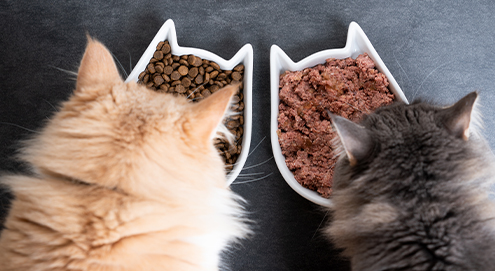Appetite stimulant for cats
Written by Tommy |
There are various reasons for cats to have a loss of appetite, like illness or stress. Even when your cat’s been treated for an illness it can take a while for its appetite to come back. An appetite stimulant may be the answer! But do these exist for cats?

Why isn’t my cat eating?
It may happen that your cat has less appetite than normal, or maybe doesn’t even want to eat at all. There’s always a reason for this and it’s important to find out what exactly that reason is. A cat that’s ill or in pain may eat less, but loss of appetite can also be caused by stress. It may be difficult for an owner to recognise the signs of a loss of appetite, because some cats are just picky and easily bored with their food. Switching these cats to another food could be the answer.
What do I do when my cat doesn’t want to eat?
Taking your cat to the vet to rule out a physical problem when your cat has a loss of appetite is always wise.
Cats have to eat. A cat has a fast metabolism and will lose weight quickly without food and can become nauseated due to hepatic steatosis. Hepatic steatosis causes more nausea and it’s very hard to stop this negative cycle.
Stimulating a cat’s appetite
When there’s no physical reason for a loss of appetite, you may need to stimulate your cat’s appetite. You can do this in several ways:
- Make sure their food bowl is clean: cats are very clean animals and don’t like a dirty food bowl.
- Use a bigger food bowl or one made of a different material: cats may find it annoying when their whiskers touch the sides of the bowl.
- Wet kibble with warm water or lightly heat wet food in the microwave: this gives the food a stronger smell and may entice your cat to eat.
- Switch to a different flavour of food: cats are very picky and changing the flavour may help.
- Switch to a different brand: some cats just like one brand more than the other, comparable to a premium brand cola and a store brand cola. Note: gradually switch to a different brand to prevent symptoms like diarrhoea and vomiting.
- Add a little something, like cooked chicken or fish: this can help your cat attract to the food. This may lead to your cat not wanting to eat anymore without the additives.
- Use a supplement to stimulate the appetite.
- Use a prescribed appetite stimulant: there are medications that stimulate the appetite, like Mirtazapine. These come in tablets, but also in an ointment (Mirataz). Don’t use this when there’s a medical reason for your cat’s loss of appetite.
Supporting your cat’s loss of appetite through its diet
A cat that’s nauseated can develop a food aversion. Switching to a different food can help. There are special diets, that are easily digestible, tasty with a soft structure and have a higher energy content to compensate for the lessened food intake. Examples are the Purina Pro Plan Veterinary Diets CN Convalescence Dog & Cat or the Royal Canin Recovery.
Does your cat eat but not enough to keep up its weight? Or could your cat use something on top of its food to gain a little weight? Adding a supplement like Virbac Nutribound or Nutri-plus gel to your cat’s food may help.
Do you have any questions about appetite stimulants for cats? Contact us at veterinarian@vetsend.co.uk.



